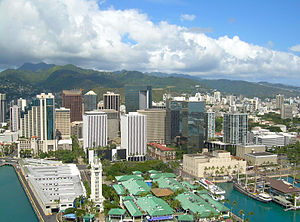
By CHARLES E. ROESSLER and ERIC LIPTON
Published: February 27, 2010
KAUAI, Hawaii — Tsunami waves arrived in Hawaii on Saturday afternoon, as predicted, causing erratic surges in the sea, but the impact was not nearly as great as had been feared. The rising water did not appear to cause significant property damage, officials said, and a tsunami warning was canceled.
Austin Larson/European Pressphoto Agency
With a tsunami warning in effect, Jason Heun and Jake Fender found higher ground Saturday on top of their van in Honolulu.
Bruce Omori/European Pressphoto Agency
Police officers in Hilo, Hawaii, as residents braced for a possible tsunami generated by the quake.
“It is a reason just to be relieved,” said Gov. Linda Lingle.
The tsunami warnings were set off by an 8.8-magnitude earthquake that struck Chile. Hawaii had waited anxiously most of the morning for the arrival of the tsunami, with officials clearing the beaches of sunbathers and swimmers, rousing tourists from beachfront hotels or confining them to the upper floors and advising everyone else to head to higher ground.
Evacuation alarms first sounded in Hawaii’s vulnerable coastal areas at 6 a.m. Saturday, as the region prepared for what federal officials said could be a dangerous — but most likely not catastrophic — tsunami. Officials warned that waves could reach as high as 6 to 10 feet in the hardest hit areas, with the tsunami first hitting Hilo Bay on Hawaii Island at 11:05 a.m., Honolulu at 11:37, and Kauai at 11:42 as it moved up the island chain.
Shortly before noon, the Pacific Tsunami Warning Center in Ewa Beach, Hawaii, announced that the first tsunami wave had indeed reached Hawaii, but live televised views of the surf at Hilo Bay — a spot traditionally hard hit in tsunamis — showed only the tide moving in and out in erratic pulses.
Tom Williamson, who lives in a relatively low-lying area east of Waikiki near Koko Crater, received a warning about the tsunami in a 4 a.m. text message from his daughter in Argentina. Expecting the coastal roads to soon be crowded, he and his family grabbed food and laptops and headed to a relative’s home on the hillside of Mt. Tantalus above Honolulu.
“We knew we had plenty of time and were not afraid,” Mr. Williamson said. “But we played it safe and got out of there.”
Later in the morning, cars packed the hillside roads above Honolulu, their passengers creating an almost festive, tailgating feeling as they cautiously made the best of the situation, eating chili and rice and sharing what they had. Local residents came out of their homes to report the latest news and to reassure those awaiting an all-clear signal, which came here about 2 p.m.
The decision of whether to evacuate coastal areas rested with state and local officials in Hawaii, a Homeland Security official said. But Hawaii did not issue a statewide evacuation order, instead leaving that decision to individual counties.
The warnings prompted many boat owners to move their boats away from the coast. Beaches were closed and evacuation zones in certain coastal areas were cleared.
Tourists at high-rise resort hotels were advised that they would be safe above the third floor.
The last Pacific-wide tsunami warning like Saturday’s was in 1964, said Brian R. Shiro, a geophysicist at the warning center.
Some regional warnings in Hawaii, including one in 1994, have passed with no tsunami impact at all. But tsunamis have also caused major damage and some loss of life in Hawaii, most recently in 1975, when two people were killed, Mr. Shiro said.
In May 1960, a 9.5-magnitude earthquake in central Chile — the largest ever recorded — set off a tsunami that hit the Hawaiian islands about 15 hours later, causing $75 million in damage and killing 61 people.
Charles E. Roessler reported from Kauai, Hawaii, and Eric Lipton from Washington. Peter Baker contributed reporting from Washington.
A version of this article appeared in print on February 28, 2010, on page A17 of the New York edition.

![Reblog this post [with Zemanta]](http://img.zemanta.com/reblog_e.png?x-id=e0941b99-e553-422c-aca0-1bc04e30d212)
No comments:
Post a Comment